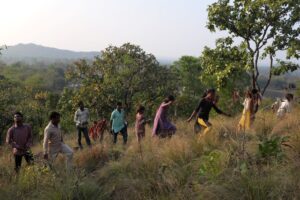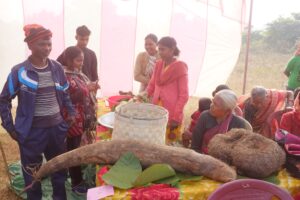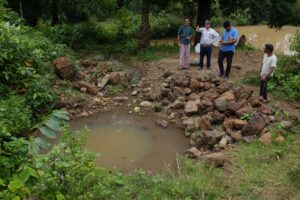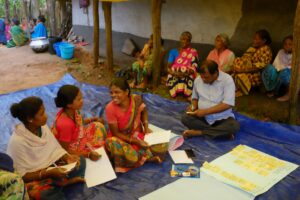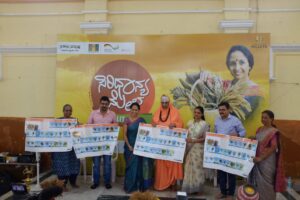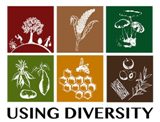Littipara
Meeting at Kathalpara village, 15th February 2018
We had a meeting with 8 women SHG members and two men from Kathalpara village. Kathalpara is home to 60 households a majority of which belong to the Pahariya community. The village still has neighbouring forest areas and a few households still practice Kurwa the traditional Pahariya agricultural practice on hill slopes. A majority of the households still practice traditional mixed cropping on small plots in plain lands known as Bakri. However, most farmers have adopted modern agriculture and are cultivating rice largely for self cultivation.
Jharkhand Vikas Parishad (JVP) who is lending support to our activities in the block also works in Kathalpara with a focus on strengthening local institutions especially women based institutions like SHGs, women’s health, and improved awareness of government provisions, schemes and processes among the villagers.
The facilitation of the meeting was supported by members of JVP – Subhasini Soren (Chief Functionary), Sanjiv Singh (Project Officer) and Santosh (Field Officer).
Force Field Exercise with villagers – we carried out a force field exercise on food security in Kathalpara with the villagers through which they identified the major positives with regards to food security in their villages as well as the major challenges they are currently facing. The results of the exercise were as follows:
Positives with regards to food security in the village:
i. Through the Dakiya Yojna all village households are receiving basic rations, namely rice, kerosene oil, sugar and salt.
ii. The villagers cultivate rice using modern agricultural practices which provides them with adequate rice to meet their household self consumption needs for 8 to 9 months.
iii. Most village households still practice Bakri cultivation on plain land through which they cultivate Kurti, Makai, Rahar, Sorso and some til. This helps add vital nutrition to their diet.
iv. A few households are still practicing Kurwa on hill slopes where they cultivate bajra, barbatti, sutra, makai, rahar, kurti and til. These crops constitute a rich source of nutrition, but sadly the practice of Kurwa has diminished considerably in the village.
v. The villagers also collect a variety of uncultivated food from their forest areas which include kend, kathal, bhelwa, semul, bhelpa, kurse, putka, nappe and chutke. The villagers were also able to identify a number of wild tubers, leafy vegetables, mushrooms, fruits and seeds from the UD books on UF which they still collect from their forest areas in addition to the above mentioned UF.
 vi. In order to meet additional food needs over and above what they can meet through the cultivation of rice, traditional agriculture and UF collection the villagers sell a variety of produce from forests and community land to traders and in local markets in order to generate cash income to purchase food from the market. The commercially traded products include – bamboo, firewood, ber, imli, mahua, bel, Mango, semul ka sava. This cash income is largely used to purchase rice.
vi. In order to meet additional food needs over and above what they can meet through the cultivation of rice, traditional agriculture and UF collection the villagers sell a variety of produce from forests and community land to traders and in local markets in order to generate cash income to purchase food from the market. The commercially traded products include – bamboo, firewood, ber, imli, mahua, bel, Mango, semul ka sava. This cash income is largely used to purchase rice.
Challenges with regards to food security:
 i. Water shortage is the most crippling issue facing the village. Villagers face an acute shortage of water for agricultural purposes. There is a serious shortage of drinking water and villagers have to travel considerable distances to access drinking water. In summer months virtually all water sources in the village dry up completely.
i. Water shortage is the most crippling issue facing the village. Villagers face an acute shortage of water for agricultural purposes. There is a serious shortage of drinking water and villagers have to travel considerable distances to access drinking water. In summer months virtually all water sources in the village dry up completely.
ii. There is a shortage of cooking oil.
iii. The villagers receive 35kg of ration rice from the government per household per month which is not sufficient as each household has 6 to ten members.
iv. Lack of employment in the village makes it difficult for villagers to generate necessary cash income required to meet additional food requirements. This forces the villagers to migrate.
v.The Anganwadi centre is quite far from the village which makes it difficult for young mothers to access vital provisions and services.
Planning for establishment of Community Seed Bank and revival of traditional crops
Kalidas Malto carried out consultations and discussions with farmers and women SHG groups with regards to revival of traditional crops that have disappeared from the area and the establishment of and SHG managed community seed bank aimed at providing seeds of crops that are disappearing from the region to interested farmers. Kalidas also showed farmers a variety of seed samples brought from Baigachak in order to facilitate identification of different crops and seeds that have diminished or disappeared from the area.
Some of the major crops that have diminished or disappeared from the Pahariya villages of Littipara based on seed samples from Baigachak are as follows
| Sr. No. | Seed name in Baiga | Seed name in Pahariya | Seed name in English |
| 1 | Sawa | Muto | Barnyard Millet |
| 2 | Bade Kodo | Koda | Kodo Millet |
| 3 | Bhrusa Kang | Kodme | Finger Millet |
| 4 | Sikiya | Layo | Pearl Millet |
| 5 | Laki Kang | Patge | Foxtail Millet |
| 6 | Lal Madia | Batwe | Finger Millet |
| 7 | Silahi Kutki | Gunjli | Little Millet |
| 8 | Kuse/Kursa | Velvet bean |
*This is an initial list prepared with the support of Hiralal from Baigachak, villagers of Littipara block and with English names provided by Soumik. This list will be confirmed and finalised in subsequent visits.
Based on discussions with farmers and JVP staff it has been decided that in 2018-19 the project would focus on the revival of the following crops based on cultural and dietary importance:
i. Muto
ii. Koda
iii. Kodme
iv. Patge
v. Kuse/Kursa
While most of these crops have largely disappeared from Pahariya villages of Littipara block they are still being cultivated in Sundar Pahari block where the Kurwa cultivation is still practiced on a large scale. Surjo Pahariya, the UD fellow from Sundar Pahari block has promised to make available the following seeds to Kalidas for the farmers of Littipara villages:
i. Muto – 10 Kg
ii. Koda – 10 Kg
iii. Kodme – 10 Kg
iv. Kursa – 2 kg
The other seeds would be sourced in small quantities for initial pilot cultivation from Baigachak.
The community seed bank will be established in Makhni Pahar village and will be managed by a women’s SHG from Makhni Pahar. In addition to the above mentioned seeds and other traditional crops the seed bank would also stock and supply a variety of local and traditional vegetable seeds and plants.
The vegetables identified for the seed bank are as follows:
i. Tomato
ii. Brinjal
iii. Dhania
iv. Palak
v. Gandhari Sag
vi. Mooli
vii. Ramtrie
viii. Sem
ix. Kadima
x. Bhalu
xi. Onion
xii. Garlic
xiii. Pumkin
xiv. Green Chilli
The purchase and collection of seeds and establishment of the SHG managed community seed bank at Makhni Pahar will be carried out in March and April 2018. Kalidas with support of experienced farmers will facilitate training programs with the SHG members on seed storage, seed bank management and plantation process.
Sundar Pahari – 17th and 18th February 2018
17th February 2018 – Field visit to the Pahariyas Forest and Traditional Cultivation areas, and meeting at Ghaghri
 Accompanied by Soumik Banerjee and Surjo Pahariya I visited forest and agricultural areas of the Pahariya project villages and had a brief meeting with 4 SGH members from Maspara and Ghagri at Ghaghri. The hills inhabited by the Pahariyas were a mix of forest and agricultural patches under shifting cultivation. The Pahariyas continue to practice their traditional form of shifting cultivation which involves:
Accompanied by Soumik Banerjee and Surjo Pahariya I visited forest and agricultural areas of the Pahariya project villages and had a brief meeting with 4 SGH members from Maspara and Ghagri at Ghaghri. The hills inhabited by the Pahariyas were a mix of forest and agricultural patches under shifting cultivation. The Pahariyas continue to practice their traditional form of shifting cultivation which involves:
i. Jara / Dari – This refers to cultivation carried out in the first year. In the first year the small trees or shrubs are cleared in July and in August they plant barbatti (cow pea). Minimal burning is carried out and two barbatti seeds are sown in each small pit made using a Khunta (wooden stick or staff). The plants flower in October and are harvested in December. The first year only involves the cultivation of barbatti.
 ii. Kurwa – After the cultivation of barbatti they practice Kurwa which involves the clearing and burning of the previous year’s residual leaves and stems in May and June. This is followed by the plantation of a variety of crops which include Makai, layo, muto, bajra (sorgum), arhar, patge, kursa, kodme, bora. They cultivate a large variety of crops through Kurwa and in addition they also grow a variety of vegetables like jhinga, kakdi, bhindi and karela. Earlier they used to carry out Kurwa cultivation for 3 years but now this has been reduced to 2 years after which they leave the land fallow for trees to grow back and return to the same area to commence Jara only after 3 to 4 years.
ii. Kurwa – After the cultivation of barbatti they practice Kurwa which involves the clearing and burning of the previous year’s residual leaves and stems in May and June. This is followed by the plantation of a variety of crops which include Makai, layo, muto, bajra (sorgum), arhar, patge, kursa, kodme, bora. They cultivate a large variety of crops through Kurwa and in addition they also grow a variety of vegetables like jhinga, kakdi, bhindi and karela. Earlier they used to carry out Kurwa cultivation for 3 years but now this has been reduced to 2 years after which they leave the land fallow for trees to grow back and return to the same area to commence Jara only after 3 to 4 years.
An interesting observation during the field visit was the fact that there were a number of mature forest patches which were roughly 8 to 10 years old. A possible explanation for proposed by Soumik was that the Pahriyas have started preferring Siam weed patches to areas with tree cover. Siam weed ( Chromolaena odorata / Eupatorium odoratum ) has become widespread especially in Kurwa areas. Being a sun loving plant it grows fast in the upper slopes where Jara and Kurwa are practiced. The Pahariyas prefer to carry out Jara and Kurwa in Siam weed patches because it is easier to cut and burn, the leaves of Siam weed are a good manure for the cow pea crop and they are also able to reduce their fallow period to one year. Siam weeds other benefits include its medicinal properties, the leaves are used to clot blood from wounds, biochar can be made from it. However, the negatives include its allelopathic effects which prevent other native trees and plants from growing their by contributing to deforestation and loss a variety of local plant and tree species. Siam weed patches also proving an excellent hiding place for wild boar which are responsible for considerable crop depredation.
In Ghagri we conducted a card sorting exercise on different kinds of Tubers and Fruits and Seeds collected from forests by them.
18th February 2018 – Meeting on forests and UF at Bada Palma village
On the 18th of February a meeting at Bada Palma with 15 women SHG members and 6 men was facilitated by Surjo Pahariya, Lata Pahariya from Ghagri village and Dharmendra Palma of Bada Palma. Soumik also provided necessary inputs and support. An overview of the UD project was provided to those present with a focus on the objectives of community led documentation of traditional agriculture and crops, uncultivated food, supporting revival of traditional crops and practices through community seed banks and provision of seeds and associated support to local farmers, building pride and awareness of traditional crops and UF through community events like UF and beej melas; supporting communities in understanding and commencing processes for securing habitat and forest rights. Discussions on current issues and challenges with respect to Kurwa cultivation and use of forests and forest resources were also carried out.
Some of the major UF listed are as follows:
 a. Tubors – Ihali, Talkohali, Pandgauhali. Jageali, Eswali, Nappe, Tigo Churke.
a. Tubors – Ihali, Talkohali, Pandgauhali. Jageali, Eswali, Nappe, Tigo Churke.
b. Wild Vegegtables – Komo Sage, Aradio Sage, Kisko Sage, Nalo Sage, Bodo Sage, Silo Sage, Kakro and Dumri.
c. Wild Fruits – Telo, kande, wild mango, dumri, phoja, paniral, piyare (fruit and seeds).
In addition the villagers also collect leaves for plates and glasses (puru) which they use themselves and sell in Damru haat. They also collect, use and sell a variety of datun for cleaning your mouth and they get all house construction material from their forests.
Dharmendra Pahariya – “Bajar men koi bhi jaroorat padega to jayenge dokan, lekin hume koi bhi jaroorat pade jaribooti se leke khane ya mun saaf karne yah koi bhi saman lane hum dukan ke jaise hi jungle jate hain. Jungle se hin samn milta hain. Ek tarah ka garib ka dukan jungle hi hain.”
 The villagers reported that earlier the forests were very good and they would get everything they needed from nearby forest areas. But now forests close to the village are gradually being cleared, so if they need anything they have to go a little far to access forest produce. Also, the youngsters of today are reducing their usage of forest produce and are increasingly using market products, for instance with respect to datum they do not know the various different datun species so are unable to collect datun. Nowadays since forests are diminishing they are not getting forest produce as easily or in large quantities as before.
The villagers reported that earlier the forests were very good and they would get everything they needed from nearby forest areas. But now forests close to the village are gradually being cleared, so if they need anything they have to go a little far to access forest produce. Also, the youngsters of today are reducing their usage of forest produce and are increasingly using market products, for instance with respect to datum they do not know the various different datun species so are unable to collect datun. Nowadays since forests are diminishing they are not getting forest produce as easily or in large quantities as before.
Land Tenure Issues – After a prolonged and violent struggle with the British the Pahariyas were able to secure rights to carry out Kurwa on their lands and they still have the titles issued to them in this regard by the British in the late 19th Century. These rights have been recognised in the Post Independence period as well and their lands are classified as revenue land for which they have titles and continue to carry out Kurwa cultivation and have forest areas which they own that don’t fall under the jurisdiction of the forest department. This is true for some areas in Littipara block as well where Pahariya villagers have rights and titles to forest areas. In this regard, there is a need for further exploration of land tenure issues in the region before taking up habitat rights and FRA issues.
Community Seed Bank Preparation –
Collection and purchase of traditional seeds for the community seed bank has commenced and seeds purchased till date are as follows –
i. Muto
ii. Batwe
iii. Ramda
iv. Gardhi
v. Kodme
vi. Lal Bajra
vii. Patge
Collection of the following seeds is being carried out –
i. Ghagri
ii. Kursa – Sada / Kala
iii. Lal Makka
iv. Safed Makka
v. Peela Makka
vi. Padha
 In addition foxtail millet, barnyard millet and kutki seeds which have disappeared from the region would be purchased from Baigachak as part of seed exchange between communities.
In addition foxtail millet, barnyard millet and kutki seeds which have disappeared from the region would be purchased from Baigachak as part of seed exchange between communities.
With regards to seed storage traditional Kochri’s are going to be prepared. It is estimated that 10 Kochri’s will be required for the seed bank and at a rate of Rs. 820 per kochri the total estimated cost for seed storage containers is Rs. 10,000.


